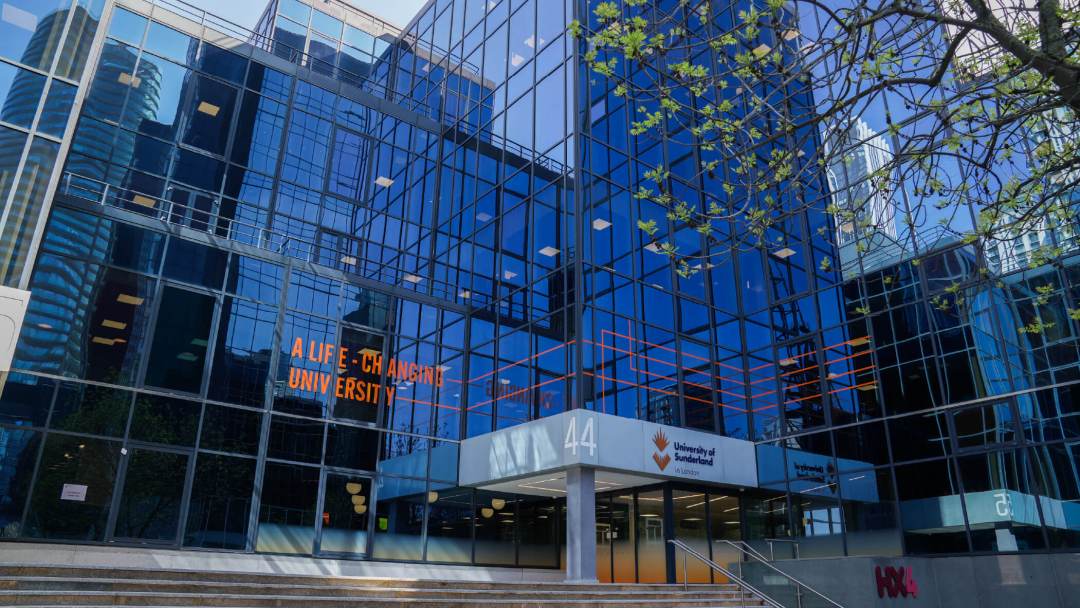Designing a data-driven campus before day one with Planon
Overview: Turning a relocation into a leap forward
When the University of Sunderland in London found itself outgrowing its campus, it didn’t see it as a problem, but as a rare opportunity. Itseized the chance to design intelligent operations before moving into a bigger space, demonstrating a proactive and forward-thinking approach towards smart campus transformation.
As it expanded into Harbour Exchange Square, located in the heart of Canary Wharf, the university again chose Planon’s Campus Management Solution as its central platform. Alongside, it partnered with key technology partners such as Terabee and IAdea tobuild a smart campus where staff and students work with confidence, not guesswork. Together, the real-time occupancy sensors, visual room displays, and integrated booking systems now deliver visibility and control that transform daily campus life and optimise real estate usage.
The Challenge: The visibility gap in campus operations
‘Our operations were growing, but our building obviously wasn’t. And as the lease was coming to an end, it was decided that we were going to look for new premises,’
– Sarah Morgan, Business Systems & Information Officer, University of Sunderland
Since establishing itsLondon presence in 2012, the University of Sunderland in London has seen a significant surge in demand. By 2024, itsexisting space couldn’t contain the 6,000+ domestic and international students.There wasalso rising enrolment pressure. The challenge was similar to that of all thriving institutions: how to support more students when physical space reaches its limits.
Upon closer examination of itsreal estate constraints, the universitydiscovered a deeper operational challenge. Itsexisting space planning and management approach relied entirely on people’s experience and intuition, lacking any data-backed foundation. Staff often used familiar spaces and trusted their judgment about availability. When room availability wasn’t immediately visible, scheduling conflicts meant people had to hunt for alternatives or interrupt colleagues already settled in spaces.
The universityfollowed an annual space planning ritual where they conducted manual surveys. However, it only epitomised the overall guesswork approach. Despite experimenting withdifferent survey timingsevery year, the ideal timing was always missed. It was nearly impossible to accurately estimate when students and staff were most active. As a result, the guesswork around survey timing resulted in expensive data that offered limited insights or value for day-to-day operations.
Therelocation to a bigger space at the Harbour Exchange Square, was viewed as more than just a space expansion; It was a rare opportunity to build intelligence from the ground up rather than retrofitting solutions afterwards.
The Solution: Planon as the digital command centre
‘We weren’t fixing a problem. For once, we had a bit of advance notice and could build something with vision from the ground up, notes Morgan.
With itsnew facility under construction and the painful lessons of data-free operations fresh in mind, the university recognised the need for a solution that could deliver the intelligence its growing operation demanded. Itwanted real-time visibility into how spaces were being used, not annual snapshots. Itneeded systems that would give staff and students confidence and ease in their daily decisions, instead of guesswork and confusion.
As a solution, the team at the University of Sunderland in London chose Planon’s Integrated Workplace Management System (IWMS) and positioned it as itsdigital command centre from day one. Tailormade for higher education campuses, this platform would serve as the brain connecting all campus operations.
The strategic framework of this new campus revolved around four mission-critical systems: reactive maintenance for immediate response, planned maintenance for systematic upkeep, asset management for lifecycle optimisation, and occupancy tracking with room booking for intelligent space utilisation. Planon would unite all four systems within a single platform, transforming the uncertainty and disconnected workflows into a seamless, confident experience for staff and students.
Sarah Morgan, leading this transformation from the Sunderland headquarters, always kept the user experience at the centre of every decision. Despite the lack of a dedicated data or estates team in London, she orchestrated smooth coordination across locations, departments, and technical teams, ensuring that the needs and experiences of staff and students were always a top priority.
Implementation: A three-pronged smart campus build
‘One of the biggest struggles with this project is we were trying to do something as they were building the building,’ Morgan recalls.
1. Real-time occupancy intelligence
The team deployed Terabee infrared sensors across all teaching rooms to capture and feed continuous occupancy data directly into Planon. These compact, precision instruments powered by PoE wereinstalled on ceilings. The sensorscount people as they enter and exit spaces, producing accurate, real-timeusage data every minute of every day.
‘You walk from the dark to the light, back out to the dark, and it counts you in. Same for going out,’ explains Morgan.
The core benefit of the system is clear: by tracking the actual number of people using each space, the University can directly tie occupancy to teaching activity and funding models. The chosen system also provides insights into library utilisation,for example, identifying which shelves are accessed most frequently.
As with any new technology deployment in a complex estate, the team did work through the usual initial considerations of ceiling height, room layout, and coexisting systems to ensure proper execution. Moving partitions, mobile furniture, and multiple entry points all required careful planning to ensure accuracy of the data recorded. The installation team also made adjustments so the infrared sensors could run seamlessly alongside existing accessibility features. In particular, they were calibrated to work in harmony with infrared hearing loops — a common requirement in higher education buildings.
Post-tuning to these specificities around the University’s environment, the upgraded system now successfully eliminates the need for costly annual occupancy surveys. Instead, staff now have 365-day visibility of space usage, can generate reliable reports instantly, and make evidence-based decisions about space allocation and investment.
2. Colour-coded visual availability displays
‘Visually, we wanted something that would tell us what was going on behind the door,’ says Morgan.
IAdeapanels, powered by PoE, were installed outside teaching and meeting room doors to eliminate the confusion and space-hunting that hindered staff and students daily. These transformed every corridor into an intelligent navigation system with colour changes signifying availability status from a distance.
The teaching spaces received non-touch panels connected directly to the timetable system (CMIS), Meeting rooms and breakout areas featured interactive touchscreens enabling instant booking through multiple channels.
As all panels connect directly to Planon’s central database, they now show real-time room availability that people can trust at a glance. Since every booking feeds directly into the unified system, all availability displays aresynchronised across the campus.
3. Campus-specific governance
‘We didn’t want London staff accidentally booking Sunderland rooms and vice versa,’ explains Morgan.
Within Planon’s central system, campus-specific permissions and data views wereconfigured to eliminate any confusion. With the same platform managing both London and Sunderland simultaneously, the permission architecture was configured in a manner that prevented cross-campus confusion through role-based access controls. This approach ensures individuals can only view and manage spaces relevant to their specific campus.
Results: Five transformational breakthroughs
The smart campus approach has delivered measurable improvements across every aspect of operations and inspired confidence where uncertainty once ruled daily operations.
1. Continuous intelligence replaces annual uncertainty
The transformation from expensive, inaccurate yearly surveys costing about £10–12K per year to real-time sensor data has fundamentally changed how the university understands and manages its spaces.
‘We’ve now got a 365-look at what’s going on,’ confirms Morgan.
This shift matters because space planning decisions affect every aspect of campus life. Previously, staff making room assignments, scheduling decisions, or capacity planning worked with data that was months old and potentially inaccurate. Now, with real-time occupancy flowing into Planon continuously, they can see actual usage patterns, identify peak demand periods, and optimise space allocation based on how people use the campus. This clarity enables proactive management instead of reactive problem-solving, helping staff make decisions that better serve the 6,000+ students who depend on these spaces for their education.
2. Triple-system attendance monitoring ensures accurate tracking and compliance
The university has achieved perfect alignment between three critical data streams: timetables, swipe-card access, and sensor occupancy. With all this data feeding into Planon, there’s comprehensive attendance intelligence that maps who isactually present versus who isscheduled to be there versus who has swiped in. This integration delivers particular value for international student visa compliance requirements.
With 6,000+ international students, the university must demonstrate accurate attendance monitoring to regulatory authorities. The triple-system approach provides robust evidence of actual attendance patterns, ensuring the university can confidently meet its compliance obligations while supporting student success.
3. A transformed culture based on friction-free user experience
The installation of room panels has revolutionised how people navigate across the campus. Visual availability cues outside every space eliminate the frustration of hunting for rooms and make it as simple as scanning a hallway.
‘Instead of looking through the vision panel of every room, they can now look down the hallway and see: red, red, red, green — I’m going to that room,’ describes Morgan.
4. Campus-level authorisation maintains focus
Localised access controls are delivering site autonomy without system complexity. Planon’s intelligent permissions ensure people see only relevant spaces, preventing confusion and giving users confidence they’re working with the right information for their location.
5. Scalable blueprint established
‘This was a proof of concept for a wider rollout at theSunderland campus. London has demonstrated that the smart campus model works at scale, providing a proven blueprint for expanding this approach across other sites.
Future plans: Scaling the smart campus vision
Sunderland’s London campus transformation has sparked a fundamental shift in campus operations and established the blueprint for university-wide expansion. The next phase will deepen support across the wider estate with several strategic initiatives planned for implementation:
- Library intelligence expansion: Sensor networks will be extended to monitor usage patterns in open-access zones. This will provide students with real-time information about productive study spaces available instantly.
- Event space capacity monitoring: Real-time occupancy pilots are underway to transform extensive event management. Screens showing safe, real-time headcount are envisaged to help organisers and attendees understand space and safety parameters. With a clear view whenever any spaces have more people than the desired headcount, they will be better equipped to act proactively and take immediate steps towards safety.
‘We want to see a television screen saying there are 90 people in this room. Ifit goes red at 215, someone can go and act on it to ensure safety,’ explains Morgan
- FM contractor integration: An API link is being developed betweenthe FM contractor’s CAFM system and Planon.This integration will enable maintenance requests created in Planon to flow directly to external contractors, with completion updates feeding back into the university’s central system. Once this happens, keeping staff informed about maintenance progresswill be much easier.
- Unified data visualisation: Dashboards are being builtthat consolidate Planon, CMIS, and swipe attendance data into a comprehensive intelligence platform with Planon as the primary data source. This data visualisation will give leadership quick and unprecedented insights into campus operations.
- Building management system connection: A potential integration ofPlanon with Schneider’s building management systems is being investigated. If feasible, this will enable comprehensive environmental and operational control.

- Student Population: 6,000+ students
- Location: Harbour Exchange Square, Canary Wharf
- Facility Type: Multi-floor modern campus
- System Coverage: Complete room booking and maintenance management
- Technology Partnership: Planon IWMS with integrated sensor networks
- Operational Model: Smart campus with real-time occupancy tracking
The University of Sunderland in London represents the future of intelligent educational space management, serving as both an operational facility and an innovation testbed for university-wide digital transformation.



